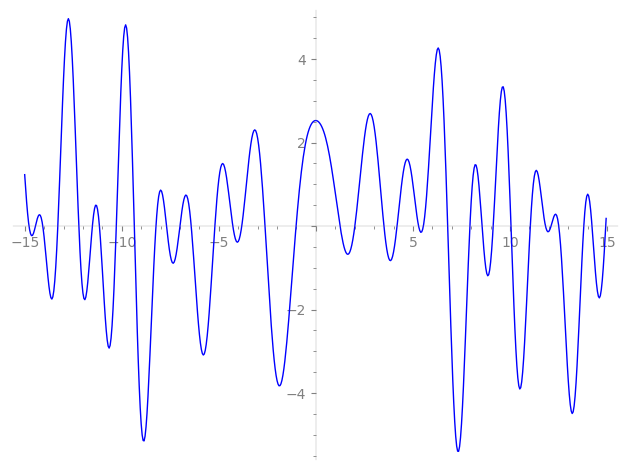| L(s) = 1 | + (0.707 + 0.707i)2-s + 1.00i·4-s + (−1.25 + 1.84i)5-s + (3.10 − 3.10i)7-s + (−0.707 + 0.707i)8-s + (−2.19 + 0.416i)10-s + 3.82·11-s + (0.0891 − 0.0891i)13-s + 4.39·14-s − 1.00·16-s + (1.83 − 1.83i)17-s + (2.70 − 3.41i)19-s + (−1.84 − 1.25i)20-s + (2.70 + 2.70i)22-s + (−2.58 − 2.58i)23-s + ⋯ |
| L(s) = 1 | + (0.499 + 0.499i)2-s + 0.500i·4-s + (−0.562 + 0.826i)5-s + (1.17 − 1.17i)7-s + (−0.250 + 0.250i)8-s + (−0.694 + 0.131i)10-s + 1.15·11-s + (0.0247 − 0.0247i)13-s + 1.17·14-s − 0.250·16-s + (0.443 − 0.443i)17-s + (0.620 − 0.784i)19-s + (−0.413 − 0.281i)20-s + (0.576 + 0.576i)22-s + (−0.539 − 0.539i)23-s + ⋯ |
\[\begin{aligned}\Lambda(s)=\mathstrut & 1710 ^{s/2} \, \Gamma_{\C}(s) \, L(s)\cr =\mathstrut & (0.859 - 0.510i)\, \overline{\Lambda}(2-s) \end{aligned}\]
\[\begin{aligned}\Lambda(s)=\mathstrut & 1710 ^{s/2} \, \Gamma_{\C}(s+1/2) \, L(s)\cr =\mathstrut & (0.859 - 0.510i)\, \overline{\Lambda}(1-s) \end{aligned}\]
Particular Values
| \(L(1)\) |
\(\approx\) |
\(2.529235269\) |
| \(L(\frac12)\) |
\(\approx\) |
\(2.529235269\) |
| \(L(\frac{3}{2})\) |
|
not available |
| \(L(1)\) |
|
not available |
\(L(s) = \displaystyle \prod_{p} F_p(p^{-s})^{-1} \)
| $p$ | $F_p(T)$ |
|---|
| bad | 2 | \( 1 + (-0.707 - 0.707i)T \) |
| 3 | \( 1 \) |
| 5 | \( 1 + (1.25 - 1.84i)T \) |
| 19 | \( 1 + (-2.70 + 3.41i)T \) |
| good | 7 | \( 1 + (-3.10 + 3.10i)T - 7iT^{2} \) |
| 11 | \( 1 - 3.82T + 11T^{2} \) |
| 13 | \( 1 + (-0.0891 + 0.0891i)T - 13iT^{2} \) |
| 17 | \( 1 + (-1.83 + 1.83i)T - 17iT^{2} \) |
| 23 | \( 1 + (2.58 + 2.58i)T + 23iT^{2} \) |
| 29 | \( 1 - 3.60T + 29T^{2} \) |
| 31 | \( 1 + 3.60iT - 31T^{2} \) |
| 37 | \( 1 + (7.07 + 7.07i)T + 37iT^{2} \) |
| 41 | \( 1 - 11.2iT - 41T^{2} \) |
| 43 | \( 1 + (-7.93 - 7.93i)T + 43iT^{2} \) |
| 47 | \( 1 + (-0.463 + 0.463i)T - 47iT^{2} \) |
| 53 | \( 1 + (3.21 - 3.21i)T - 53iT^{2} \) |
| 59 | \( 1 - 9.40T + 59T^{2} \) |
| 61 | \( 1 - 8.21T + 61T^{2} \) |
| 67 | \( 1 + (-8.78 - 8.78i)T + 67iT^{2} \) |
| 71 | \( 1 - 1.66iT - 71T^{2} \) |
| 73 | \( 1 + (3.64 + 3.64i)T + 73iT^{2} \) |
| 79 | \( 1 - 8.82T + 79T^{2} \) |
| 83 | \( 1 + (-0.347 - 0.347i)T + 83iT^{2} \) |
| 89 | \( 1 + 9.79T + 89T^{2} \) |
| 97 | \( 1 + (-6.88 - 6.88i)T + 97iT^{2} \) |
| show more | |
| show less | |
\(L(s) = \displaystyle\prod_p \ \prod_{j=1}^{2} (1 - \alpha_{j,p}\, p^{-s})^{-1}\)
Imaginary part of the first few zeros on the critical line
−9.354653539072294181903940900991, −8.237398314641261032258773315616, −7.69231147999388220732066972391, −7.00246996092058648238001240493, −6.42314818994899698366168355261, −5.20375037905457045237224067800, −4.27774727381306488390471463685, −3.81950741249633826752803100397, −2.62158517421680889350610386714, −1.02115089396666829268939922760,
1.24371159933570713410706137037, 2.00534270912952353013363307360, 3.50500854291196442945950411020, 4.17963952331369974288445300540, 5.29011812319012261598565287731, 5.53465339515326694080320918077, 6.78861998075213257001536969170, 7.932737167635658219114793100700, 8.559349238992586075742253137455, 9.132796117398357832622150139317

